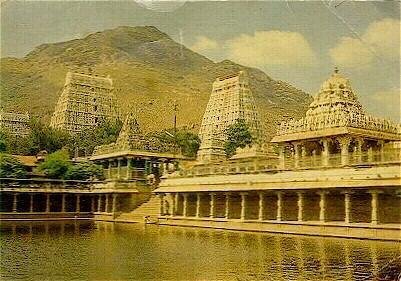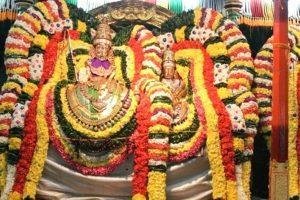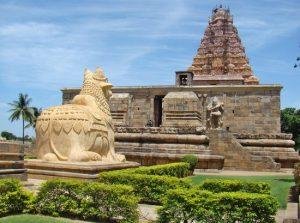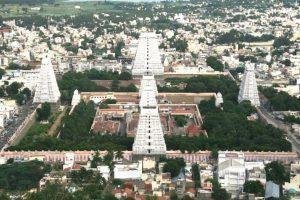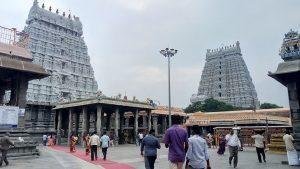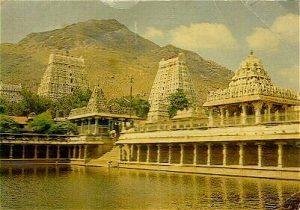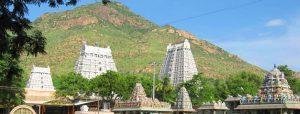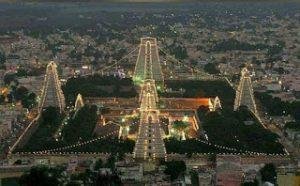Arunachalesvara Temple, Tiruvannamalai, Tamil Nadu
| Date built: | – |
|---|---|
| Deity: | Arunachalesvara(Shiva) Unnamalai Amman (Apitakuchambaal – Parvati) |
| Architectural style: | Dravidian architecture |
| Major festivals | Karthigai Deepam |
| Locale: | Tiruvannamalai |
| District:: | Tiruvannamalai |
| Address: | Pavazhakundur, Tiruvannamalai, Tamil Nadu 606601 |
| Phone | 04175252438 |
Arunachalesvara Temple, also called Annamalaiyar Temple, is a Hindu temple dedicated to the deity Shiva, located at the base of Arunachala hill in the town of Thiruvannamalai in Tamil Nadu, India. It is significant to the Hindu sect of Saivism as one of the temples associated with the five elements, the Pancha Bhoota Stalas, and specifically the element of fire, or Agni. Shiva is worshiped as Arunachalesvara or Annamalaiyar, and is represented by the lingam, with his idol referred to as Agni lingam. His consort Parvati is depicted as Unnamalai Amman.The presiding deity is revered in the 7th century Tamil Saiva canonical work, the Tevaram, written by Tamil saint poets known as the nayanars and classified as Paadal Petra Sthalam. The 9th century Saiva saint poet Manikkavasagar composed the Tiruvempaavai here.
The temple complex covers 10 hectares, and is one of the largest in India.[3] It houses four gateway towers known as gopurams. The tallest is the eastern tower, with 11 stories and a height of 66 metres (217 ft), making it one of the tallest temple towers in India.[3] The temple has numerous shrines, with those of Arunachalesvara and Unnamalai Amman being the most prominent. The temple complex houses many halls; the most notable is the thousand-pillared hall built during the Vijayanagar period.
The temple has six daily rituals at various times from 5:30 a.m. to 10 p.m., and twelve yearly festivals on its calendar. The Karthigai Deepam festival is celebrated during the day of the full moon between November and December, and a huge beacon is lit atop the hill. It can be seen from miles around, and symbolizes the Shiva lingam of fire joining the sky.The event is witnessed by three million pilgrims. On the day preceding each full moon, pilgrims circumnavigate the temple base and the Arunachala hills in a worship called Girivalam, a practice carried out by one million pilgrims yearly.
The present masonry structure was built during the Chola dynasty in the 9th century, while later expansions are attributed to Vijayanagar rulers of the Sangama Dynasty (1336–1485 CE), the Saluva Dynasty and the Tuluva Dynasty (1491–1570 CE). The temple is maintained and administered by the Hindu Religious and Charitable Endowments Department of the Government of Tamil Nadu.
Architecture
The temple is situated at the bottom of the Arunachala hills, and faces east, lying over 25 acres. The walls on the east and west measure 700 ft (210 m), the south 1,479 ft (451 m), and the north 1,590 ft (480 m). It has four gateway towers, the gopuram, on its four sides. The eastern tower, the Rajagopuram, is the tallest in the temple. The base of the Rajagopuram is made of granite, measuring 135 ft (41 m) by 98 ft (30 m).It was begun by king Krishnadevaraya (1509–29 CE) of the Vijayanagara dynasty, and completed by Sevappa Nayaka (1532–80 CE). The inscriptions indicate that the tower was built at the behest of Sivanesa and his brother Lokanatha in 1572 CE.The south tower is called Thirumanjangopuram, and the west, Pei Gopuram. Ammani Amman gourami in the north.Raghunathabhyudayam and Sangitha Sudha, both Nayak scriptures, also describe the towers. The Tanjavuri Andhra Raja Charitamu mentions that Krishnadevaraya built the tower and the outer precincts of the temple.The temple has a total of five precincts, each of which holds a huge Nandi, the sacred bull of Shiva. Towers include the Vallala Maharaja Gopuram and Kili Gopuram, or Parrot Tower.
Shrines
The main shrine of Arunachalesvara faces east, housing images of Nandi and Surya, and is the oldest structure in the temple. Behind the walls of the sanctum, there is an image of Venugopalaswamy, an incarnation of Vishnu. Around the sanctum, there are images of Somaskandar, Durga, Chandekeswarar, Gajalakshmi, Arumugaswami, Dakshinamoorthy, Swarnabairavar, Nataraja, and Lingodbhavar—the last an image of Shiva emanating from lingam. The Palliyarai, the divine room for resting deities, is located at the first precinct around the sanctum. The shrine of his consort, Unnamulai Amman, lies in the second precinct, with Amman depicted in a standing posture. Sambantha Vinayagar, the elephant god shrine, is located to the north of the flagstaff and the Bali peeta, or platform for sacrifice.To the south of the thousand-pillared hall, there is a small shrine for Subramaya and a large tank. Pathala Lingam, the underground lingam, is the place where Ramana Maharshi (1879 – 1950 CE) is believed to have performed his penance.The shrine of Sivagangai Vinayagar is present in the northern bank of the Sivanganga tank.
There is a sixteen pillared Deepa Darshana Mandapam, or hall of light, in the third precinct. The temple tree, Magizha, is considered sacred and medicinal, and childless couples tie small cradles to its branches in obeisance. Vedas write that the mast of the temple separated the earth and the sky during creation of the universe.The Kalyana Mandapam, the marriage hall, is in the south-west of the precinct, and is built in Vijayanagara style. A stone trident is present in the outer shrine of the temple in open air, and has protective railings like a sacred tree. The Vasantha Mandapam, meaning the Hall of spring, is the third precinct, and contains the temple office and Kalahateeswarar shrine.The fourth precinct has an image of Nandi, Brahma Theertham, the temple tank, the Yanai Thirai Konda Vinayaga shrine, and a hall with a six-foot-tall statue of Nandi, erected by Vallala Maharaja.
Inside the doorway of the first tower and the fifth precinct, there is a thousand-pillared hall built during the late Vijayanagara period.Krishnadevaraya constructed the hall and dug the tank opposite to it. The pillars in the hall are carved with images of yali, a mythological beast with body of lion and head of an elephant, a symbol of Nayak power.The Arunagirinathar Mandapam is located to the right of the Kalayana Linga Sundara Eswara Mandapam, and the Gopurathilayanar shrine is to the left of a broad flight of stone stairs that lead up to the Vallala Gopuram.
Legend / Local stories
The present masonry and towers date back to the 9th century CE, as seen from an inscription in the structure made by Chola kings who ruled at that time. Further inscriptions indicate that before the 9th century, Tiruvannamalai was under the Pallava Kings, who ruled from Kanchipuram.[13] The 7th century Nayanar saints Sambandar and Appar wrote of the temple in their poetic work, Tevaram. Sekkizhar, the author of the Periyapuranam wrote that both Appar and Sambandar worshiped Arunachalesvara in the temple.The Chola Kings ruled over the region for more than four centuries, from 850 CE to 1280 CE, and were temple patrons. The inscriptions from the Chola king record various gifts like land, sheep, cow and oil to the temple commemorating various victories of the dynasty.The Hoysala kings used Tiruvannamalai as their capital beginning in 1328 CE.There are 48 inscriptions from the Sangama Dynasty (1336–1485 CE), 2 inscriptions from Saluva Dynasty, and 55 inscriptions from Tuluva Dynasty (1491–1570 CE) of the Vijayanagara Empire, reflecting gifts to the temple from their rulers. There are also inscriptions from the rule of Krishnadeva Raya (1509–1529 CE), the most powerful Vijayanagara king, indicating further patronage.Most of the Vijayanagara inscriptions were written in Tamil, with some in Kannada and Sanskrit.The inscriptions in temple from the Vijayanagara kings indicate emphasis on administrative matters and local concerns, which contrasts the inscriptions of the same rulers in other temples like Tirupathi. The majority of the gift related inscriptions are for land endownments, followed by goods, cash endowments, cows and oil for lighting lamps.The town of Tiruvannamalai was at a strategic crossroads during the Vijayanagara Empire, connecting sacred centers of pilgrimage and military routes.There are inscriptions that show the area as an urban center before the precolonial period, with the city developing around the temple, similar to the Nayak ruled cities like Madurai.
During the 17th century CE, the temple along with the Tiruvannamalai town came under the dominion of the Nawab of the Carnatic. As the Mughal empire came to an end, the Nawab lost control of the town, with confusion and chaos ensuing after 1753.Subsequently, there were periods of both Hindu and Muslim stewardship of the temple, with Muraru Raya, Krishna Raya, Mrithis Ali Khan, and Burkat Ullakhan besieging the temple in succession. As European incursions progressed, Tiruvannamalai was attacked by French Soupries, Sambrinet, and the English Captain Stephen Smith. While some were repelled, others were victorious. The French occupied the town in 1757, and the temple along with the town came under control of the British in 1760. In 1790 CE, Tiruvannamalai town was captured by Tippu Sultan, who ruled from 1750–99 CE.During the first half of the 19th century, the town along with the temple came under British rule.From 1951, under the provision of the Hindu Religious and Charitable Endowments Act, the temple has been maintained by the Hindu Religious and Endowment Board (HR &CE) of the Government of Tamil Nadu. In 2002, the Archaeological Survey of India declared the temple a national heritage monument and took over its stewardship. Widespread protests and litigation with the Supreme Court of India, however, led the Archaeological Survey to cede the temple back to the Hindu Religious and Endowment Board.
In Hindu mythology, Parvati, wife of Shiva, once closed the eyes of her husband playfully in a flower garden at their abode atop Mount Kailash. Although only a moment for the gods, all light was taken from the universe, and the earth, in turn, was submerged in darkness for years. Parvati performed penance along with other devotees of Shiva.Then her husband appeared as a column of fire at the top of Arunachala hills, returning light to the world. He then merged with Parvati to form Ardhanarishvara, the half-female, half-male form of Shiva.The Arunachala, or red mountain, lies behind the Arunachalesvara temple, and is associated with the temple of its namesake. The hill is sacred and considered a lingam, or iconic representation of Shiva, in itself.
Another legend is that once, while Vishnu and Brahma contested for superiority, Shiva appeared as a flame, and challenged them to find his source.Brahma took the form of a swan, and flew to the sky to see the top of the flame, while Vishnu became the boar Varaha, and sought its base. The scene is called lingothbava, and is represented in the western wall at the sanctum of most Shiva temples. Neither Brahma nor Vishnu could find the source, and while Vishnu conceded his defeat, Brahma lied and said he had found the pinnacle. In punishment, Shiva ordained that Brahma would never have temples on earth in his worship.
Photo Gallery
How to Reach:
Contact Details
Official Address

